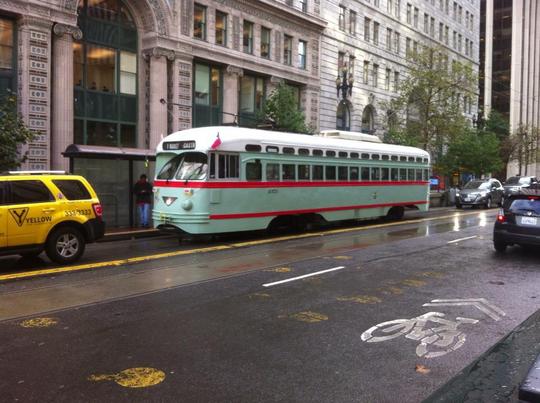More than eight years ago, Muni purchased 11 PCC streetcars from Newark, New Jersey. The F-line was way overcrowded, and because the Newark streetcars had been well maintained, the thought was that they could be put into service quickly.
The last one in the group, No. 1073, started carrying passengers for the first time today.

PCC No. 1073, honoring El Paso-Juarez, on its first day of F-line service on lower Market Street, November 28, 2012. Jeremy Whiteman photo. Click to enlarge.
This has been some odyssey. Michael Burns, then-general manager of Muni, ordered the 11 ex-Newark streetcars be put into service as quickly as possible, with new exterior paint jobs, ADA modifications, front trolley poles for San Francisco’s back-up operations, and the bare minimum of fix-up work. This was done under a contract with Brookville Equipment Company in Pennsylvania, and the streetcars were shipped back to San Francisco, where a couple went into service.
But then the then-head of operations, Fred Stephens, decreed that the interior of the streetcars, which had not been upgraded because of the desire to hurry them to the street, did not meet his standards. Back to Brookville under another contract.
Back came the streetcars to San Francisco again, with about half going into service. But then, it was found that the wiring was original to the cars and worn out, causing reliability problems. That led to a third contract with Brookville, now winding down. The 11 cars of the 1070-class (numbered from 1070 to 1080) were completely rewired and given new propulsion packages based on the original PCC technology.
The 11 cars were thoroughly tested before going into service, with a major focus on the new door controllers, which were initially balky and unreliable. They’re still not optimal, and Market Street Railway has been advocating with Muni to identify more reliable systems for future PCC renovations.
Several of the 1070 class never made it into passenger service during the first two renovations, so over the past year, regular passengers would be surprised to see “new” streetcars in paint schemes honoring such cities as Toronto or Mexico City.
This last PCC of the class to enter service is hard to miss. It wears an unusual green livery adopted in the 1960s by El Paso City Lines and only used for a few years. This version of the El Paso livery was chosen because an earlier version was identical to the “fruit salad” livery worn by PCC No. 1080, which honors Los Angeles Transit Lines. Both companies were part of National City Lines, which bought up numerous private streetcar companies and converted most of them them to buses after World War II. (Note to railfans: hold the comments on the conspiracy theory, please; it’s been hashed over to death. For those interested in background, go here.)
The crossed American and Mexican flags painted on the streetcar’s front (another authentic touch) reminds riders that the El Paso PCCs were the only ones to run an international route. On the actual El Paso PCCs, the seats were longitudinal — continuous benches against the sidewalls of the cars (like Muni’s Milan trams), so that government inspectors could process passengers more quickly.
El Paso shut down its streetcar lines in 1974, but lately, there has been talk of using six surviving actual El Paso PCCs for a downtown circulator there. (No international service, though.)
Meanwhile, we here in San Francisco say “Bienvenidos” to No. 1073. Your long wait to carry passengers here is over!
One minor correction — the seating was for convenience of Mexican customs authorities, who walked through the cars to inspect riders. Cars crossing into the US discharged all passengers just prior. Passengers entered US as pedestrians. The streetcar moved forward into the US and passengers reboarded, paying a new (10 cent) fare. Fare to board in Juarez was 2 cents.
Thanks for the great article.